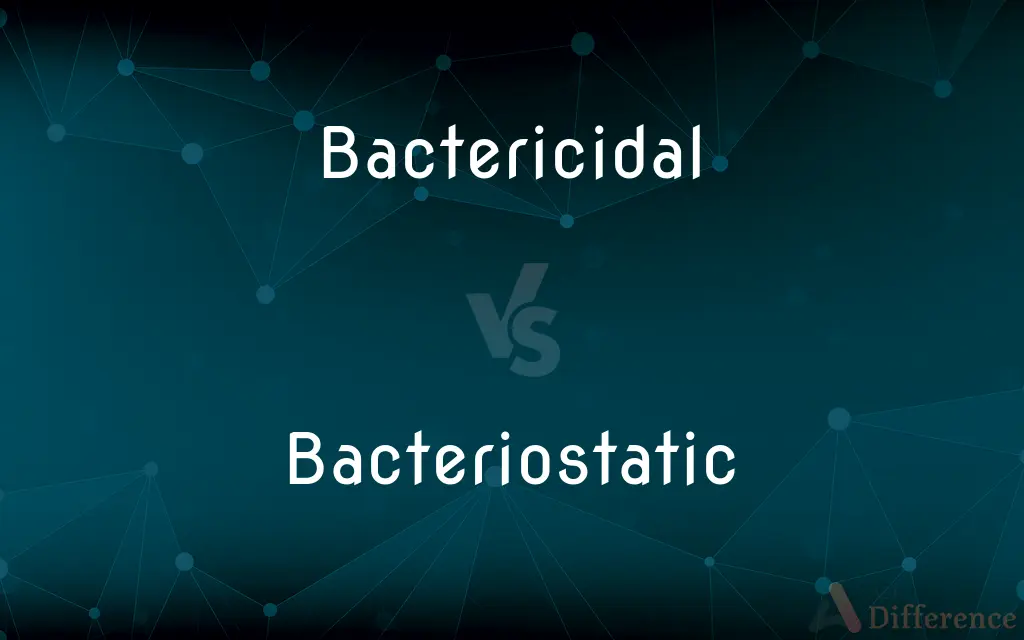Bactericidal vs. Bacteriostatic — What's the Difference?
By Tayyaba Rehman & Urooj Arif — Updated on April 18, 2024
Bactericidal agents kill bacteria, directly causing their death, while bacteriostatic agents inhibit bacterial growth, halting reproduction but not killing them outright.

Difference Between Bactericidal and Bacteriostatic
Table of Contents
ADVERTISEMENT
Key Differences
Bactericidal agents are designed to kill bacteria, making them useful in situations where rapid and complete eradication of a bacterial population is necessary. On the other hand, bacteriostatic agents prevent the growth and reproduction of bacteria, effectively containing the infection without necessarily killing the bacteria immediately.
The choice between bactericidal and bacteriostatic agents can depend on the type of infection and the overall health of the patient. While bactericidal agents are often preferred in life-threatening situations, bacteriostatic agents are beneficial in scenarios where preserving the body's microbial balance is important.
Bactericidal antibiotics, such as penicillin and cephalosporins, work by disrupting the cell walls of bacteria, leading to cell death. Whereas, bacteriostatic antibiotics, like tetracyclines and erythromycin, inhibit protein synthesis which is crucial for bacterial growth and replication.
The effectiveness of bactericidal drugs can be measured directly by the decrease in the number of viable bacteria. In contrast, the effectiveness of bacteriostatic drugs is determined by their ability to maintain bacterial counts at a stable level without further increase.
In some cases, the use of bacteriostatic agents can be preferable, as they are less likely to disrupt the normal flora of the body. Conversely, bactericidal agents may be more likely to cause side effects due to their aggressive action against bacteria.
ADVERTISEMENT
Comparison Chart
Primary Action
Kills bacteria
Inhibits bacterial growth
Common Types
Penicillin, Cephalosporins
Tetracyclines, Erythromycin
Preferred Use
Life-threatening infections
Non-critical infections
Impact on Bacterial Population
Rapid reduction in number
Stabilizes or slows growth
Potential Side Effects
Higher disruption of normal flora
Lower disruption of normal flora
Compare with Definitions
Bactericidal
Destroys bacteria by disrupting vital processes.
Bactericidal antibiotics are essential for treating severe bacterial infections.
Bacteriostatic
Resistance can develop if underdosed.
Inadequate dosing of bacteriostatic antibiotics may lead to resistance.
Bactericidal
Often used in severe healthcare settings.
Bactericidal drugs are preferred in hospital-acquired infections.
Bacteriostatic
Less likely to disrupt body's natural flora.
Bacteriostatic antibiotics are preferable for long-term therapy.
Bactericidal
Typically causes irreversible damage to bacteria.
Bactericidal agents often target bacterial cell walls, causing cell lysis.
Bacteriostatic
Often used in combination with other antimicrobials.
Bacteriostatic agents are frequently combined with other drugs to enhance effectiveness.
Bactericidal
Can lead to bacterial resistance if used improperly.
Misuse of bactericidal antibiotics can foster resistant bacterial strains.
Bacteriostatic
Suitable for treating a wide range of infections.
Bacteriostatic agents are versatile in managing skin and respiratory infections.
Bactericidal
Requires careful dosing and monitoring.
Dosing of bactericidal drugs must be precise to avoid toxicity.
Bacteriostatic
Inhibits bacterial cell replication.
Bacteriostatic drugs are used when the immune system needs support to clear an infection.
Bactericidal
A substance or agent that destroys bacteria.
Bacteriostatic
An agent, such as a chemical or biological material, that inhibits bacterial growth.
Bactericidal
That kills bacteria.
Bacteriostatic
Of or relating to bacteriostasis or a bacteriostat; inhibiting the growth of bacteria without destroying them.
Bactericidal
Of or pertaining to a bactericide.
Bacteriostatic
Of or pertaining to bacteriostasis or a bacteriostat.
Bactericidal
A bactericide.
Bacteriostatic
Causing bacteriostasis; - said of chemical substances, such as certain antibacterial agents.
Bactericidal
Destructive of bacteria.
Bacteriostatic
Of or relating to or causing bacteriostasis
Bactericidal
Preventing infection by inhibiting the growth or action of microorganisms
Common Curiosities
What are bacteriostatic antibiotics?
Bacteriostatic antibiotics are drugs that prevent bacteria from growing and reproducing but do not kill them outright.
When should one use bactericidal antibiotics?
Bactericidal antibiotics are typically used in severe infections where quick and complete eradication of bacteria is necessary.
Can bactericidal and bacteriostatic antibiotics be used together?
Yes, combining bactericidal and bacteriostatic antibiotics can be effective in certain treatments, but should be done under medical supervision to avoid antagonistic effects.
What are bactericidal antibiotics?
Bactericidal antibiotics are drugs that kill bacteria directly by disrupting their vital functions.
What are the advantages of bacteriostatic antibiotics?
Bacteriostatic antibiotics are advantageous in managing infections where a gradual treatment approach is suitable, allowing the body’s immune system to combat the bacteria effectively without harsh disruption to the microbiome.
How do bacteriostatic drugs work?
Bacteriostatic drugs inhibit the growth and reproduction of bacteria by interfering with protein synthesis or other cellular functions necessary for bacterial replication.
Are bacteriostatic drugs always safe to use?
While bacteriostatic drugs are generally considered safer in terms of disrupting normal flora, they must be used properly to avoid resistance.
How do bactericidal drugs work?
Bactericidal drugs work by attacking the vital structures or processes of bacterial cells, such as the cell wall or DNA replication, leading to bacterial death.
What are the advantages of bactericidal antibiotics?
The main advantage of bactericidal antibiotics is their ability to quickly reduce bacterial populations, which is crucial in acute or life-threatening infections.
What are some examples of bacteriostatic antibiotics?
Typical examples are tetracycline and chloramphenicol, which inhibit bacterial protein synthesis.
Can the misuse of bactericidal drugs lead to bacterial resistance?
Yes, improper or excessive use of bactericidal drugs can promote the development of bacterial resistance, making infections harder to treat with standard antibiotics.
Is there a risk of resistance with bacteriostatic antibiotics?
Bacteriostatic antibiotics also carry a risk of developing resistance, particularly if underdosed or used improperly, allowing bacteria to adapt to the inhibitory effects.
In which clinical scenarios might bacteriostatic antibiotics be preferred?
Bacteriostatic antibiotics are preferred in scenarios where it is beneficial to inhibit bacterial growth and allow the immune system to clear the infection, such as in less severe infections or for patients with a strong immune response.
Are there specific patient conditions that favor bactericidal over bacteriostatic antibiotics?
Bactericidal antibiotics are often favored in patients who are immunocompromised or critically ill, as these patients benefit from the rapid reduction in bacterial levels.
What are some examples of bactericidal antibiotics?
Common examples include penicillin, which disrupts bacterial cell wall synthesis, and fluoroquinolones, which interfere with DNA replication.
Share Your Discovery

Previous Comparison
Thorny vs. Prickly
Next Comparison
Placard vs. ArmoireAuthor Spotlight
Written by
Tayyaba RehmanTayyaba Rehman is a distinguished writer, currently serving as a primary contributor to askdifference.com. As a researcher in semantics and etymology, Tayyaba's passion for the complexity of languages and their distinctions has found a perfect home on the platform. Tayyaba delves into the intricacies of language, distinguishing between commonly confused words and phrases, thereby providing clarity for readers worldwide.
Co-written by
Urooj ArifUrooj is a skilled content writer at Ask Difference, known for her exceptional ability to simplify complex topics into engaging and informative content. With a passion for research and a flair for clear, concise writing, she consistently delivers articles that resonate with our diverse audience.















































